Fiji is a beautiful island country in the area of Melanesia, which is part of Oceania. This area consists of several other island nations like Papua New Guinea and Vanuatu.
Unfortunately, climate change is a more pressing issue for Fiji than some other countries, which will eventually affect the fish in the region. As a collection of islands, the country is uniquely vulnerable to rising sea levels and extreme weather. The country hopes to become a zero-emissions country by the year 2050. However, the reduction in the effects of climate change depends on a concerted global effort.
Fiji actually consists of more than 300 islands, of which more than 100 are inhabited. Nearly 90% of the country’s population live on two main islands, either close to the capital, Suva, or in another area where the sugar cane industry employs many. As an island nation that has historically depended on the ocean for survival, there are many amazing Fijian fish, and the country is a destination for people who love to fish.
1. Mahi Mahi
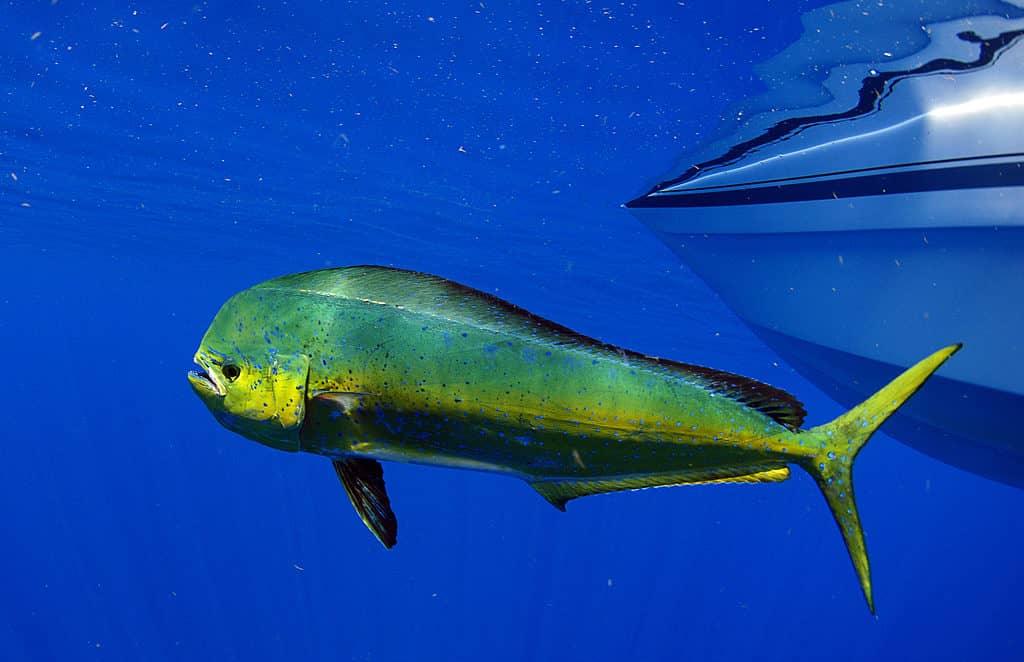
The name mahi-mahi is actually from the Hawai’ian language and means very strong.
©FtLaud/Shutterstock.com
Mahi mahi is also known as the common dolphinfish, dorado, or simply dolphin, though it is not a dolphin at all. It is a bright green fish that is found throughout the globe in tropical and subtropical ocean waters. It is found in the Atlantic, Pacific, and Indian Oceans. They are found around every continent except Antarctica, and they are a favorite fish for sports people in the Fiji area.
The name mahi-mahi is actually from the Hawai’ian language and means very strong. They may have gotten this name due to their reputation for frenzied feeding when bait is thrown into the water, or because they tend to jump out of the water and flip or twirl around when caught on the end of a line.
This fish is typically between 15 and 29 pounds. They rarely live longer than 5 years, and they eat fish, crab, and squid. Mahi are fast swimmers – they can reach speeds of up to 57 miles per hour!
The species is popular for individual sport fishers, but they are also important for commercial fishing as well, because many consider them delicious fish! They have been eaten for thousands of years. There is art from Ancient Greece dating back to the year 1600 BCE that features fishermen with catches of mahi-mahi.
Is it environmentally responsible to eat mahi-mahi? It depends on who you ask, where it was caught, and how it was caught. According to the Monterey Bay Aquarium Seafood Watch List, troll and pole-and-line mahi-mahi caught in the Atlantic are the best choice, and imported mahi-mahi caught by long-line is something to avoid. The Environmental Defense Fund also advises conscious consumers to avoid mahi mahi caught by long lines due to the fact that other animals get caught up in the lines, and this method also affects other species, such as seabirds.
2. Yellowfin Tuna

Some yellowfin tuna weigh as much as 400 pounds.
©Al McGlashan/Shutterstock.com
Yellowfin tuna also lurk in the waters around Fiji. Like mahi mahi, they are found in tropical and subtropical oceans around the globe. When you see a fish called ahi in the store, it is also most likely yellowfin tuna. However, there is something with the naming that gets a bit confusing. The scientific name is Thunnes albacares. In English, albacore is a different species of tuna fish. But in French, yellowfin is called albacore, and in Portuguese, it is called albacora. So, depending on where you are and what language you’re speaking, albacore may refer to what English speakers think of as albacore, or to yellowfin!
These fish can grow to be massive. Some weigh as much as 400 pounds. They can grow longer than 7 feet. They eat other fish, crustaceans, and squid. One thing that sets yellowfin tuna apart from other fish is that they are actually warm-blooded.
Yellowfin are important fish for both commercial and sport fishing. In commercial fishing, they are often caught using an encircling net, a tactic that is also called purse seining. However, in the 1970s, this technique brought criticism because dolphins and porpoises were getting caught up in the nets as well. Since then, commercial fisheries have continued to use this technique but have developed ways that are less likely to get dolphins caught up in the nets. However, these practices affect other species like rays and sea turtles and may affect future tuna populations because the fish caught by using these practices tend to be younger and smaller.
Yellowfin is a popular fish to use for sushi, and in cooked dishes like grilled fish. However, different organizations have different standards as to whether eating yellowfin tuna is safe for the environment. Greenpeace has it on their Seafood Red List, because, according to them, it has a high likelihood of coming from unsustainable fishing practices.
3. Marlin
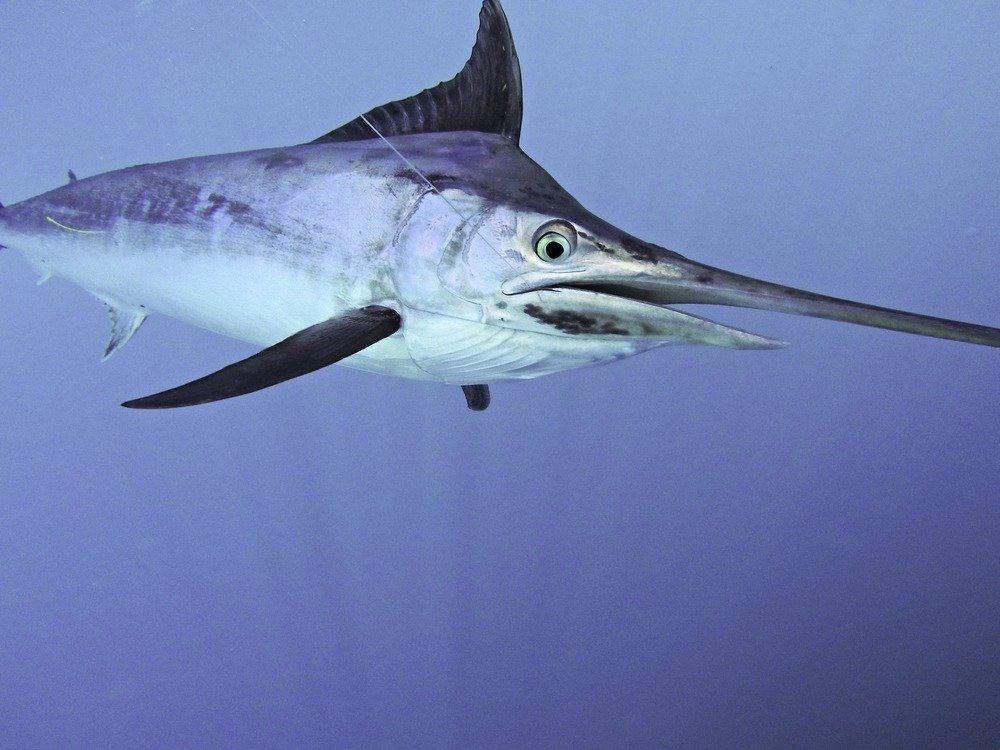
All marlin species are easily recognized by their sharp-looking nose or snout, and crested dorsal fin.
©kelldallfall/Shutterstock.com
There are 10 species of marlin overall, and three of those species are found in the waters around Fiji: black marlin, striped marlin, and Indo-Pacific blue marlin. The blue marlin is the largest of the marlin species and can grow up to 16 feet long and weigh up to around 1400 pounds. Black marlins grow up to just under 1 foot and can weigh up to 1650 pounds. The striped marlin grows to around 13.5 feet long and weighs up to 500 pounds. So, these fish are large!
All marlin species are easily recognized by their sharp-looking nose or snout, and crested dorsal fin. They mainly eat other fish and squid. This fish species was made famous in Ernest Hemingway’s beautifully written novel The Old Man and the Sea.
In many places, it is not the most common to eat marlin, and it is mostly considered a sport fish. However, it is a more popular dish in Hawai’i, Japan, and Mexico. Some experts warn that predatory fish like marlin may contain high levels of mercury, so pregnant and breastfeeding people should avoid eating them.
4. Wahoo
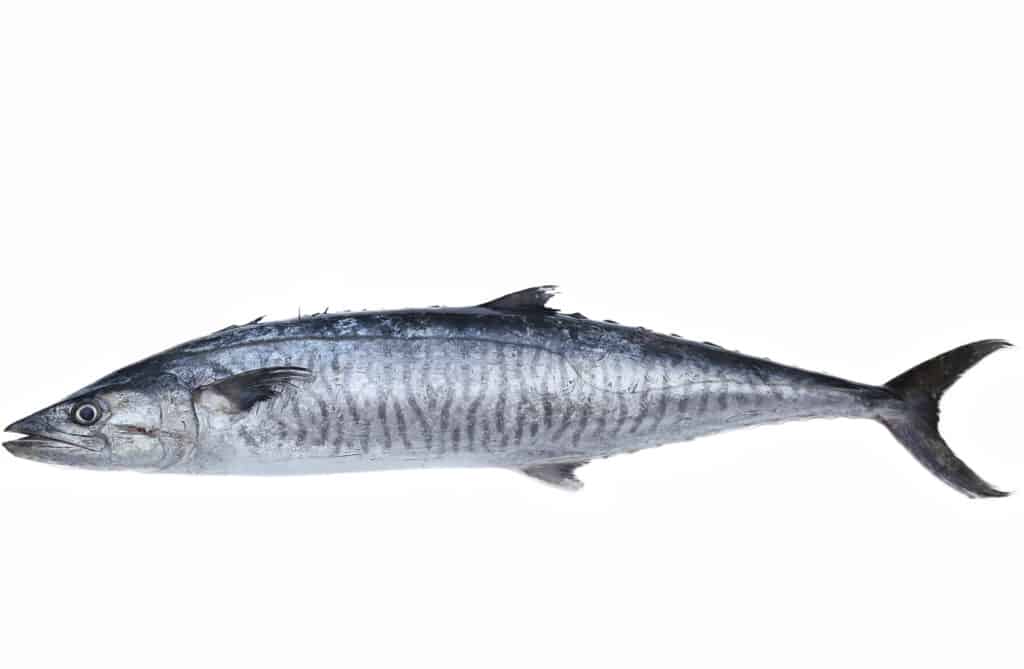
Wahoo fish have long, torpedo-shaped bodies.
©Bignai/Shutterstock.com
Wahoo is known as ono in Hawai’i and simply “hoo” in some parts of the US. It got its name because when colonizers came to the Hawai’ian island of Oahu, they often spelled the name as Wahoo. This fish was abundant in that area, so it got the name of the location.
Like many fish that are found near Fiji, it lives globally in tropical and subtropical waters. They have sharp teeth and are recognizable by their blue and grey stripes. Their diet mainly consists of other fish and squid. In rare cases, they may eat some crustaceans.
This fish species is prized by sports fishers because it tends to put up a good fight. Commercially, the wahoo is less important than easier-to-catch fish that swim in schools, like yellowfin tuna. They are more caught as a bycatch in nets, so they are not considered to be in danger of overfishing.
The fish has less fat than other species, so when cooking it, it’s important to use a method that will not dry it out. Some suggest grilling, baking, or blackening to make a delicious meal of Wahoo.
4. Pacific sailfish
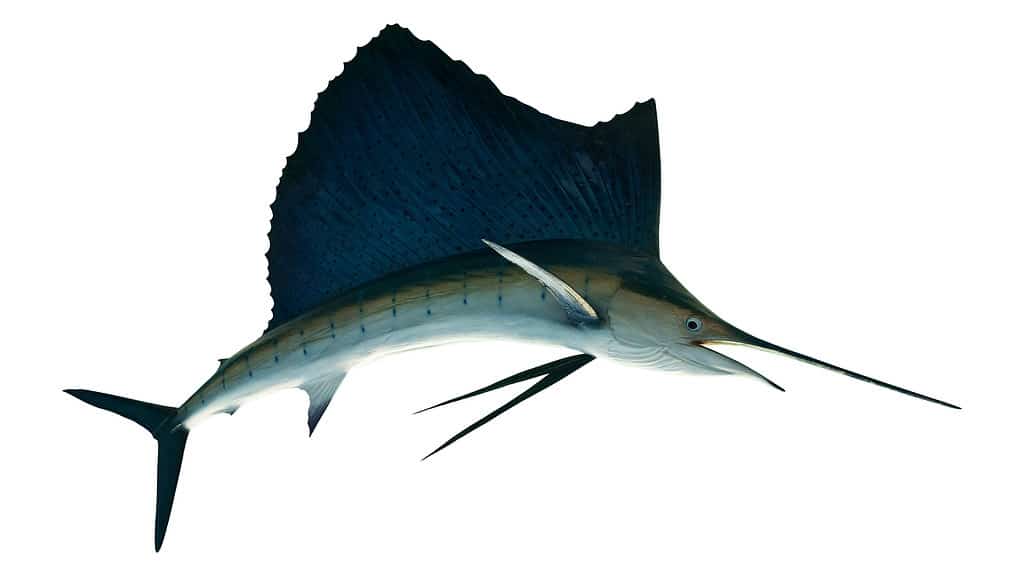
Commercially, Pacific sailfish are often caught as a bycatch and are most likely to be thrown back rather than kept to be sold.
©Stock High angle view/Shutterstock.com
The Pacific sailfish likely gets its name from the large dorsal fin that resembles a sail. Some experts believe the sail may help with regulating their body temperature. Similar to marlins, they have a long, pointed snout. They typically eat tuna and mackerel.
As a game fish, the Pacific sailfish fights hard, making it a fun catch for many. They often take hours to catch and put up a dramatic display with leaps and dives. Commercially, Pacific sailfish are often caught as a bycatch and are most likely to be thrown back rather than kept to be sold. This is because their meat is not particularly good. Some fishing enthusiasts say their flesh is hard in texture. Because of this, they are not likely to be in danger of overfishing.
5. Giant trevally

The giant trevally is important for sport and commercial fishing.
©zaferkizilkaya/Shutterstock.com
This large fish also goes by the names:
- Lowly trevally
- Barrier trevally
- Giant kingfish
- Ulua
- Ronin jack
They live in the Pacific Ocean between South Africa and Hawai’i from east to west, and Japan and Australia from north to south. They have a very distinct shape with a steeply sloped head. They grow up to 67 inches long and can weigh as much as 175 pounds. Their diet consists of fish, mollusks, crustaceans, and cephalopods. However, in rare cases, they may even leap out of the water to catch seabirds. They also follow monk seals and sharks to get better access to prey.
The giant trevally is important for sport and commercial fishing. Some people say trevally is not a good fish to eat while others enjoy it. However, it is possible to get ciguatera poisoning from eating too much of this type of fish. Herbivorous fish eat certain types of marine organisms (that are toxic to humans) that live on plants in the ocean and are then eaten by carnivorous fish such as this one. When humans then eat the carnivorous fish, they can get sick if the toxin levels are high enough. Symptoms of this type of poisoning include diarrhea, vomiting, dizziness, and feeling weak. Luckily, this type of food poisoning is only rarely deadly. In most cases, it results in an uncomfortable few days.
Sports fishers love trevally because they have a lot of endurance and often require the use of multiple techniques to catch them. They have also been important for commercial fishing. However, the species has seen a decline of more than 80% since the early 1900s due to their popularity. Because of this decline, recreational fishers are often encouraged to catch and release giant trevally. The governments of some areas where this fish is caught commercially recommend limits on catches, size, and other preventative measures to allow the species to thrive.
6. Parrotfish
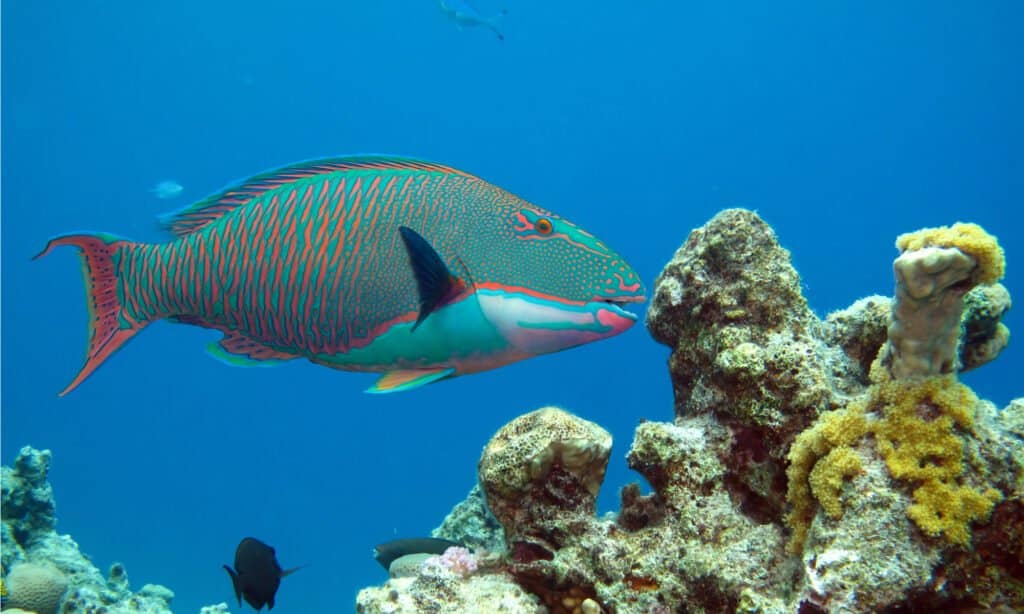
The parrotfish uses its beak-like teeth to grasp algae from corals and rocks.
©Cigdem Cooper/Shutterstock.com
Parrotfish are actually a group of 90 species of fish, many of which are found in the waters surrounding Fiji. They tend to live in coral reefs and seagrass beds. Most parrotfish species are smaller, growing up to just 20 inches long. However, a few species, like the green humphead parrotfish, can grow up to 4 feet long.
Parrotfish have been determined to be very important for the health of coral reefs, including the Great Barrier Reef. Due to their feeding behaviors, they scrape clean reefs and help them to remain healthy. They are herbivores that eat algae off the reefs. They are also responsible for the white sand on tropical beaches. They take in tiny bits of coral and poop them out as sand! According to The Nature Conservancy, some species of parrotfish can excrete 2,000 pounds of sand each year.
In the Fiji area, the parrotfish that are most overfished and depleted is the bumphead parrotfish, also known as the green humphead parrotfish. This species is popular with spearfishers and is considered good to eat. It is often sold as “grouper.” Conservation groups are trying to educate the public on why parrotfish are important to the environment to reduce their consumption.
7. Coral Trout

Coral trouts are hermaphrodites–they can change genders when external circumstances require it.
©DiveSpin.Com/Shutterstock.com
There are actually two different fish species known as coral trout that you may find in the waters surrounding Fiji.
First, Plectropomus leopardus, also called:
- Leopard coral grouper
- Common coral trout
- Leopard coral trout
- Blue-dotted coral grouper
- Spotted coral grouper
This species has a body that ranges in color from greenish to reddish-brown, with blue spots towards the top of the body. While common catches are around 14 inches long, they can grow up to 47 inches long and weigh up to 52 pounds. They live in coral reef areas and mainly feed on other reef-dwelling fish. However, young Plectropomus leopardus will also eat small crustaceans.
This species is popular for food, although they can also have higher levels of the ciguatera toxin, like the giant trevally.
The other species known as coral trout is Cephalopholis miniata, also called:
- Coral grouper
- Coral hing
- Coral rock cod
- Coral cod
- Round-tailed trout
- Vermillion seabass
This fish species’ name comes from the fact that it tends to live in coral reefs and has a coral-ish color with light blue spots. They grow up to 20 inches long and are another favorite of both sport and commercial fishers in the area. One quality that makes this fish unique is that they are hermaphrodites–they can change genders when external circumstances require it.
Up Next:
- 8 Incredible Pacific Ocean Islands
- 5 Finding Nemo Fish Species In Real Life
- What Do Parrotfish Eat?
- The Top 10 Incredible Animals That Live in Coral Reefs
The photo featured at the top of this post is © DiveSpin.Com/Shutterstock.com
Sources
- Wikipedia, Available here: https://en.wikipedia.org/wiki/Indo-Pacific_sailfish
- Hawaii-Seafood, Available here: https://www.hawaii-seafood.org/wild-hawaii-fish/wahoo/
- BigWater Adventures, Available here: https://www.bigwateradventures.com/fish_species_guide/bigwater_adventures_pacific-sailfish.php#.Y6n4VezMJJU
- Florida Museum of Natural History Gainesville, Available here: https://www.floridamuseum.ufl.edu/discover-fish/species-profiles/coryphaena-hippurus/
- The Nature Conservancy, Available here: https://www.nature.org/en-us/get-involved/how-to-help/animals-we-protect/parrotfish/
- Wikipedia, Available here: https://en.wikipedia.org/wiki/Sequential_hermaphroditism#Protogyny
FAQs (Frequently Asked Questions)
How many islands does Fiji have?
Fiji has more than 300 islands.
How many islands of Fiji are inhabited by people?
Over 100 islands of Fiji are inhabited by people.
What are some fish species found near Fiji?
Fish species found near Fiji include marlin, yellowfin tuna, wahoo, and giant trevally.
Thank you for reading! Have some feedback for us? Contact the AZ Animals editorial team.






